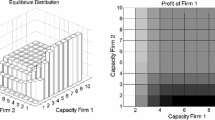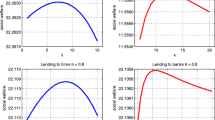Abstract
The supply and demand of credit are not always well aligned, as is reflected in the countercyclical excess reserve-to-deposit ratio and interest spread between the lending rate and the deposit rate. We develop a search-based theory of credit allocations to explain the cyclical fluctuations in both bank reserves and interest spread. We show that search frictions in the credit market can naturally explain the countercyclical bank reserves and interest spread, as well as generate endogenous business cycles driven primarily by the cyclical utilization rate of credit resources, as long conjectured by the Austrian school of the business cycle. In particular, we show that credit search can lead to endogenous local increasing returns to scale and variable capital utilization in a model with constant returns to scale production technology and matching functions, thus providing a microfoundation for the indeterminacy literature of Benhabib and Farmer (J Econ Theory 63(1):19–41, 1994) and Wen (J Econ Theory 81(1):7–36, 1998).







Similar content being viewed by others
Notes
See Sect. 5.3 for an alternative setup with competitive search. All the qualitative results derived in this paper are preserved under competitive search.
We address the issue of long-term credit relationships in a companion paper, but the basic results hold.
In a follow-up project, we study the case with required reserves and interbank lending.
Our results would be strengthened if we allow \(H_{t}\) and \(B_{t}\) to vary by costly entry as an additional margin of adjustment.
We choose this proportional cost function for comparison with the fixed search cost on the firm side (to be specified below). This way we can show which form of search costs leads to local IRS in our model.
Alternatively, the impulse response may also be driven by sunspot shock to consumption demand, which delivers a qualitatively similar result. See Wen (1998) for more details on how to introduce sunspot shocks in indeterminate DSGE models.
References
Acemoglu, D.: A microfoundation for social increasing returns in human capital accumulation. Q. J. Econ. 111(3), 779–804 (1996)
Azariadis, C., Kaas, L., Wen, Y.: Self-fulfilling credit cycles. Working Paper, Federal Reserve Bank of St. Louis (2014)
Bai, Y., Ríos-Rull, J.V., Storesletten, K.: Demand shocks as productivity shocks. Working Paper, Federal Reserve Board of Minneapolis (2012)
Becchetti, L., Garcia, M., Trovato, G.: Credit rationing and credit view: empirical evidence from loan data. Working Paper, Tor Vergata University, CEIS (2009)
Benhabib, J., Farmer, R.E.: Indeterminacy and increasing returns. J. Econ. Theory 63(1), 19–41 (1994)
Benhabib, J., Dong, F., Wang, P.: Adverse selection and self-fulfilling business cycles. NBER Working Paper (2014a)
Benhabib, J., Miao, J., Wang, P.: Chaotic banking crises and banking regulations. NBER Working Paper (2014b)
Benhabib, J., Wang, P.: Financial constraints, endogenous markups, and self-fulfilling equilibria. J. Monet. Econ. 60(7), 789–805 (2013)
Campello, M., Graham, J.R., Harvey, C.R.: The real effects of financial constraints: evidence from a financial crisis. J. Financ. Econ. 97(3), 470–487 (2010)
Cui, W., Radde, S.: Search-based endogenous illiquidity and the macroeconomy. Working Paper, UCL (2014)
Den Haan, W.J., Ramey, G., Watson, J.: Liquidity flows and fragility of business enterprises. J. Monet. Econ. 50(6), 1215–1241 (2003)
Duffie, D., Gârleanu, N., Pedersen, L.H.: Over-the-counter markets. Econometrica 73(6), 1815–1847 (2005)
Gertler, M., Kiyotaki, N.: Banking, liquidity and bank runs in an infinite-horizon economy. NBER Working Paper (2013)
Greenwood, J., Hercowitz, Z., Huffman, G.W.: Investment, capacity utilization, and the real business cycle. Am. Econ. Rev. 78(2), 402–417 (1988)
Hosios, A.J.: On the efficiency of matching and related models of search and unemployment. Rev. Econ. Stud. 57(2), 279–298 (1990)
King, R.G., Rebelo, S.T.: Resuscitating real business cycles. Handb. Macroecon. 1, 927–1007 (1999)
Lagos, R., Rocheteau, G.: Liquidity in asset markets with search frictions. Econometrica 77(7), 403–426 (2009)
Liu, Z., Wang, P.: Credit constraints and self-fulfilling business cycles. Am. Econ. J. Macroecon. 6(1), 32–69 (2014)
Miao, J., Wang, P.: Bubbles and credit constraint. Working Paper, Boston University and Hong Kong University of Science and Technology (2012)
Moen, E.R.: Competitive search equilibrium. J. Polit. Econ. 105(2), 385–411 (1997)
Petrosky-Nadeau, N., Wasmer, E.: The cyclical volatility of labor markets under frictional financial markets. Am. Econ. J. Macroecon. 5(1), 193–221 (2013)
Philippon, T.: Has the US finance industry become less efficient? On the theory and measurement of financial intermediation (No. w18077). National Bureau of Economic Research (2012)
Pintus, P.A., Wen, Y.: Leveraged borrowing and boom-bust cycles. Rev. Econ. Dyn. 16(4), 617–633 (2013)
Stiglitz, J.E., Weiss, A.: Credit rationing in markets with imperfect information. Am. Econ. Rev. 71(3), 393–410 (1981)
Wasmer, E., Weil, P.: The macroeconomics of labor and credit market imperfections. Am. Econ. Rev. 94(4), 944–963 (2004)
Wen, Y.: Capacity utilization under increasing returns to scale. J. Econ. Theory 81(1), 7–36 (1998)
Acknowledgments
We benefit from comments by the anonymous referee, Costas Azariadis, Silvio Contessi, Bill Dupor, Francois Geerolf (discussant), Rody Manuelli, Benjamin Pugsley, B. Ravikumar, Yi-Chan Tsai (discussant), José-Víctor R íos-Rull, Harald Uhlig, Randy Wright, Steve Williamson, as well as participants of 2015 ASSA meeting at Boston, the macroseminar at Federal Reserve Bank of St. Louis, the NBER conference on Multiple Equilibria and Financial Crises at Federal Reserve Bank of San Francisco, Tsinghua Workshop in Macroeconomics 2015, and The Fourth HKUST International Workshop on Macroeconomics. The views expressed are those of the individual authors and do not necessarily reflect official positions of the Federal Reserve Bank of St. Louis, the Federal Reserve System, or the Board of Governors. The usual disclaim applies.
Author information
Authors and Affiliations
Corresponding author
Appendix: Proofs
Appendix: Proofs
Proof of Proposition 1
Since each match between the household and the banking sector utilizes \(\widetilde{S}_{t}=e_{t}S_{t}\) units of household capital (savings), and each match between the banking sector and the production sector (firms) utilizes \(K_{t}=u_{t}\widetilde{S}_{t}\) units of bank capital (deposits), given the total initial available credit resources \(S_{t}\) in the economy, the fraction of aggregate credit resources ultimately utilized in production is hence given by
As each matched firm employs \(n_{t}\) units of labor, the labor market equilibrium then requires
Finally, it is easy to show that the total production output of all firms is given by
where \(K_{t}\) is determined by Eq. (31). Since \( K_{t}=e_{t}u_{t}S_{t}\), the aggregate production function in Eq. (33) can also be written as in Eq. (18).\(\square \)
Proof of Proposition 2
Substituting Eqs. (21) and (23) into Eq. (18) yields Eq. (24).
\(\square \)
Proof of Proposition 3
Equations (12) and (32) together imply
Substituting Eq. (34) into Eqs. (4), (6), and (7) yields
Consequently, we can reduce the dynamic system \(\{C_{t},S_{t},N_{t},W_{t},R_{t}^{d},R_{t}^{l},\pi _{t},K_{t},e_{t},u_{t},q_{t},\theta _{t},Y_{t},V_{t}\}\) to a simplified one with fewer variables in \(\{C_{t},S_{t},e_{t},u_{t},Y_{t},N_{t}\}\) with Eqs. (18), (21), (23), (35), (36), and (37), where \(\delta \left( e\right) \) is defined in Eq. (3). The FOCs indicate \(\delta ^{\prime }\left( e_{t}\right) =\left( 1+\kappa \right) \left( \frac{\delta \left( e_{t}\right) }{e_{t}}\right) =R_{t}^{d}\). Thus,
Log-linearizing the above simplified transition dynamics yields
Consequently, we obtain the simplified dynamic system on \(\left( s_{t},c_{t}\right) \) as
where
\(\kappa \equiv \frac{1}{\varepsilon _{H}}-1\), \(\alpha _{s}\equiv \frac{ \alpha \left( 1-\varepsilon _{H}\right) }{1-\alpha \left( \varepsilon +\varepsilon _{H}\right) }\), \(\alpha _{n}\equiv \frac{1-\alpha }{1-\alpha \left( \varepsilon +\varepsilon _{H}\right) }\), \(\lambda _{s}\equiv \frac{ \alpha _{s}\left( 1+\xi \right) }{1+\xi -\alpha _{n}}\), and \(\lambda _{c}\equiv \frac{-\alpha _{n}}{1+\xi -\alpha _{n}}.\)
Note that the local dynamics around the steady state is then determined by the eigenvalues of J. If both eigenvalues of J are negative, then the model is indeterminate. As a result, the model can experience endogenous fluctuations driven by sunspots. The eigenvalues of J, \(x_{1}\) and \(x_{2}\) satisfy
Therefore, indeterminacy emerges if and only if \(\hbox {Trace}(J) <0\) and \(\hbox {Det}(J)>0\). We can prove that \(\hbox {Trace}(J)<0\) and \(\hbox {Det}(J) >0\) if and only if the following four conditions hold, in addition to the restriction that \(\varepsilon ,\varepsilon _{H}\in [0,1]\):
First, since \(\varepsilon _{H}\in [0,1]\), comparing Conditions (38) and (41) suggests that the former is never binding. Second, note that \(\kappa \equiv \frac{1}{\varepsilon _{H}}-1\). Thus, Condition (40) can be rewritten as
Since \(\xi \ge 0,\) we have \([\frac{1+\xi -(1-\eta ) (1-\alpha )}{1+\xi }] ( \frac{1}{\alpha }) >[ 1-( 1-\eta )(1-\alpha )](\frac{1}{\alpha })>1\), and therefore, we know that Condition (40) is not binding. Finally, if \(\alpha \in [\frac{1}{2},1)\), then we know that \(\frac{1}{\alpha }-1\in (0,1]\), and we must have \(0\le \varepsilon < \frac{1}{\alpha }-1\). Besides, we know that \(\widetilde{\varepsilon }\equiv (\frac{1}{\alpha }) (1-\frac{1-\alpha }{1+\xi }) >2\) when \(\alpha \in [\frac{1}{2},1)\). Therefore, Condition (39) always holds in this case. In contrast, when \(\alpha \in (0,\frac{1}{2}) \), we have \(\frac{1}{\alpha }-1>1>\varepsilon \), and thus, Condition (41) always holds. Meanwhile, since \(\varepsilon +\varepsilon _{H}\le 2\), to guarantee that Condition (39) can be satisfied, we must have \(\widetilde{\varepsilon }\equiv ( \frac{1}{\alpha }) (1-\frac{1-\alpha }{1+\xi }) <2\), i.e., \(\xi \in [0, \frac{\alpha }{1-2\alpha })\).\(\square \)
Proof of Proposition 4
The FOCs are given by
Substituting Eqs. (42) and (43) into Eq. (18) yields
where \(\widetilde{Y}^{SP}=[(\frac{\alpha }{\delta ^{0}})^{\varepsilon _{H}}(\frac{\alpha \eta }{\varDelta ^{0}})^{\varepsilon }] ^{\frac{\alpha }{1-\alpha ( \varepsilon +\varepsilon _{H}) }}\). Dividing Eq. (24) by Eq. (44) yields Eq. (27). Then the FOC of Eq. (27) yields \(\eta ^{*}\).\(\square \)
Rights and permissions
About this article
Cite this article
Dong, F., Wang, P. & Wen, Y. Credit search and credit cycles. Econ Theory 61, 215–239 (2016). https://doi.org/10.1007/s00199-015-0916-5
Received:
Accepted:
Published:
Issue Date:
DOI: https://doi.org/10.1007/s00199-015-0916-5




